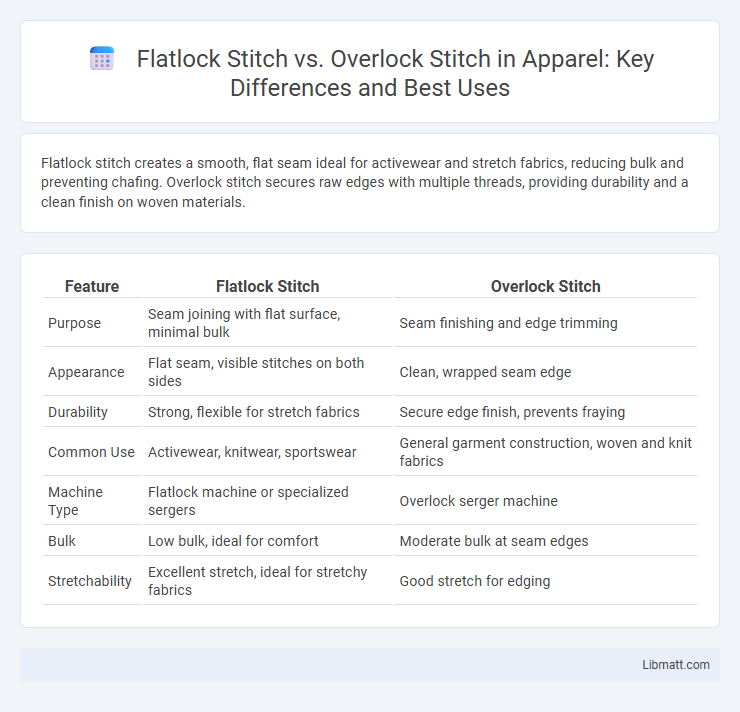Flatlock stitch creates a smooth, flat seam ideal for activewear and stretch fabrics, reducing bulk and preventing chafing. Overlock stitch secures raw edges with multiple threads, providing durability and a clean finish on woven materials.
Table of Comparison
| Feature | Flatlock Stitch | Overlock Stitch |
|---|---|---|
| Purpose | Seam joining with flat surface, minimal bulk | Seam finishing and edge trimming |
| Appearance | Flat seam, visible stitches on both sides | Clean, wrapped seam edge |
| Durability | Strong, flexible for stretch fabrics | Secure edge finish, prevents fraying |
| Common Use | Activewear, knitwear, sportswear | General garment construction, woven and knit fabrics |
| Machine Type | Flatlock machine or specialized sergers | Overlock serger machine |
| Bulk | Low bulk, ideal for comfort | Moderate bulk at seam edges |
| Stretchability | Excellent stretch, ideal for stretchy fabrics | Good stretch for edging |
Introduction to Flatlock and Overlock Stitches
Flatlock stitch creates a smooth, flat seam by joining fabric edges edge-to-edge, ideal for activewear and stretch fabrics, ensuring minimal bulk and high comfort. Overlock stitch, produced by serger machines, trims and encloses fabric edges simultaneously with multiple threads, offering durable, professional finishes and preventing fraying on various fabric types. Both stitches enhance garment construction but serve distinct purposes in seam strength and appearance.
What is a Flatlock Stitch?
A Flatlock stitch joins fabric edges by sewing them flat together without overlapping, creating a smooth, flexible seam ideal for activewear and sports garments. This stitch minimizes bulk and irritation against the skin, enhancing comfort and durability. Your choice of a flatlock stitch ensures a professional, clean finish suitable for stretchy or lightweight fabrics.
What is an Overlock Stitch?
An overlock stitch is a sewing technique that trims the fabric edge while simultaneously enclosing it with thread loops for a neat, durable finish. Commonly used in garment construction, overlock stitches prevent fraying and provide stretchability, making them ideal for knit fabrics. Industrial sergers typically perform overlock stitching, ensuring efficient, high-quality seams in mass production.
Key Differences Between Flatlock and Overlock Stitches
Flatlock stitches create a flat seam by overlapping fabric edges and sewing through both layers, ideal for sportswear and stretch fabrics due to its flexibility and minimal bulk. Overlock stitches trim the fabric edges while sewing, enclosing them with thread to prevent fraying, commonly used for seam finishing in garment manufacturing. The key difference lies in seam appearance and function: flatlock seams lie flat and are decorative, while overlock seams are strong, durable, and primarily used for edge finishing.
Applications of Flatlock Stitch in Sewing
Flatlock stitch is commonly used in activewear, swimwear, and lingerie due to its ability to create smooth, flat seams that reduce chafing and enhance comfort. This stitch is ideal for joining stretchy fabrics as it maintains fabric elasticity while providing a secure seam, making it perfect for performance garments and casual wear. Your sewing projects benefit from flatlock stitching when you need durable, flexible, and aesthetically clean seams for items worn close to the skin.
Common Uses of Overlock Stitch
Overlock stitches are commonly used for edging, hemming, and seaming knit and woven fabrics, providing a clean, professional finish that prevents fraying. These stitches are particularly effective in garment construction for activewear, lingerie, and stretch fabrics due to their strong, flexible seam. Your projects benefit from the durability and elasticity that overlock stitches offer, making them ideal for both industrial and home sewing applications.
Strength and Durability Comparison
Flatlock stitch offers superior strength and durability for seam applications requiring a flat, smooth finish, as its interlocking threads distribute tension evenly across the fabric. Overlock stitch excels in preventing seam fraying and providing elasticity, making it ideal for stretchy materials but less robust under heavy stress compared to flatlock. Your choice should consider the fabric type and the expected wear, with flatlock preferred for high-strength needs and overlock best suited for flexible, lightweight garments.
Seam Appearance and Comfort
Flatlock stitch creates seams that lie flat and smooth against the skin, reducing irritation and enhancing comfort, especially in activewear and base layers. Overlock stitch produces strong, tightly bound seams with a slight ridge that may cause friction or discomfort during prolonged wear. Your choice between these stitching methods will impact both the aesthetic finish and the wearability of the garment.
Choosing the Right Stitch for Your Project
Flatlock stitch offers a smooth, flat seam ideal for activewear or garments that require minimal irritation against the skin, enhancing comfort and durability. Overlock stitch excels in finishing raw edges and preventing fraying, making it perfect for woven fabrics and professional-looking seams. Evaluating fabric type, garment purpose, and desired seam finish will help you choose the right stitch for your project effectively.
Conclusion: Flatlock vs Overlock – Which Is Better?
Flatlock stitch provides a smooth, flat seam ideal for activewear and stretch fabrics, reducing bulk and chafing, while overlock stitch excels in finishing raw edges quickly and creating durable, strong seams for a variety of garment types. Your choice depends on the desired seam flexibility and appearance, with flatlock favored for comfort and overlock preferred for efficiency and robustness. Understanding fabric type and garment use will help determine whether flatlock or overlock stitching is better for your sewing project.
Flatlock Stitch vs Overlock Stitch Infographic

 libmatt.com
libmatt.com